 Why do we have day and night?
Why do we have day and night?
Why is a day 24 hours long?
Why does the Sun always rise in the eastern sky and set in the western sky?
What path does the Sun take as it moves across the sky?
Why are tennis courts and other sporting facilities nearly always aligned in a north-south direction?
STAR LAWS Episode I: What Causes Day and Night? answers all these questions and will really make your day!
A Short Excerpt:
EXCERPT COMING SOON.
 The STAR LAWS Episode I Question Sheet for Students:
The STAR LAWS Episode I Question Sheet for Students:
![]() The PDF version.
The PDF version. ![]()
Google The Google Doc version. Google
![]() The Microsoft Word version.
The Microsoft Word version.![]()
![]() If you have ClickView, watch the whole episode here.
If you have ClickView, watch the whole episode here.
![]() If you have Learn360, watch the whole episode here.
If you have Learn360, watch the whole episode here.
Transcript:
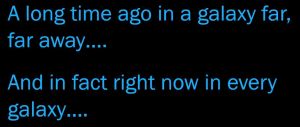

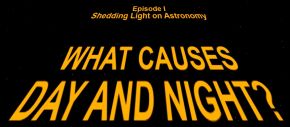

The word astronomy comes from the Greek words astron which means star and nomos which means “law”. Astron nomy therefore translates literally as STAR LAWS. Astronomy is the study of the laws of nature that govern how stars and other bodies in space appear to move across the sky, how they form, and how they change over time.
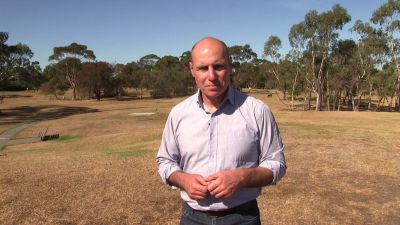 Hi Everyone, welcome to Episode I of the STAR LAWS series aka the Shedding Light on Astronomy series. In this episode we’re going to answer probably the most basic astronomy-related question that there is: Why do we have day and night?
Hi Everyone, welcome to Episode I of the STAR LAWS series aka the Shedding Light on Astronomy series. In this episode we’re going to answer probably the most basic astronomy-related question that there is: Why do we have day and night?
We’re also going to look at how the Sun appears to move across the sky during daytime. Let’s begin.
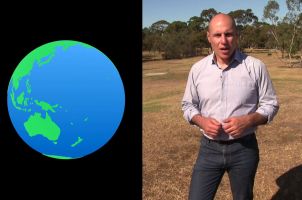


Right now, I’m standing on a gigantic ball of rock and other stuff called the Earth. You’re also on the Earth unless you’re watching this video in space.
This series of photos shows what the Earth actually looks like from space.
Behind me is the Sun, an even more gigantic ball, which is not made of rock but is made up mostly of the gasses hydrogen and helium. It continuously shines light onto the Earth and without it we’d all be in the dark.
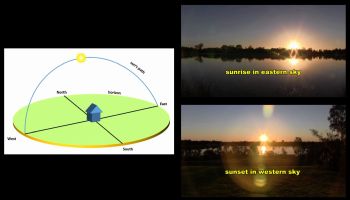 Every day we can observe the Sun rising in the eastern sky. It gets higher and higher following an upwards arc until the middle of the day when it gets to its highest point in the sky. It then begins to descend, tracing out the second half of its arc, before finally setting in the western sky.
Every day we can observe the Sun rising in the eastern sky. It gets higher and higher following an upwards arc until the middle of the day when it gets to its highest point in the sky. It then begins to descend, tracing out the second half of its arc, before finally setting in the western sky.
It looks to us as if the Sun is going around and around the Earth, but in fact, if we were in space a long way away, we would see the Earth spinning.

The Earth spins around an imaginary line called its axis, which runs from the North Pole to the South Pole. It takes about 24 hours to complete one full rotation.
Now this simple animation is not to scale, but at any given moment, about half the Earth is facing the Sun and the other half is facing away from the Sun. The side of the Earth that faces the Sun experiences daytime because it’s receiving sunlight. The side of the Earth that is facing away from the Sun experiences nighttime because it’s not receiving sunlight. On average, every point on the Earth’s surface spends half the time in daytime and half the time in nighttime.
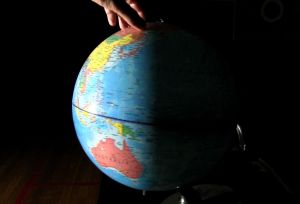 I can model day and night using a spotlight and a globe.
I can model day and night using a spotlight and a globe.
As the Earth turns, the half that is facing the Sun, that is, the spotlight experiences daytime, while the other side facing away from the Sun (the spotlight) experiences nighttime.
 Now I’ve already mentioned that the Sun rises in the east and sets in the west. Why does the Sun rise in the east and set in the west? Before I answer the question, we need to look at the concept of direction as in North, South, East, and West. Since the concept of direction is one of the most important concepts in astronomy, and lots of other subjects, we should explore the concept in a little more detail.
Now I’ve already mentioned that the Sun rises in the east and sets in the west. Why does the Sun rise in the east and set in the west? Before I answer the question, we need to look at the concept of direction as in North, South, East, and West. Since the concept of direction is one of the most important concepts in astronomy, and lots of other subjects, we should explore the concept in a little more detail.

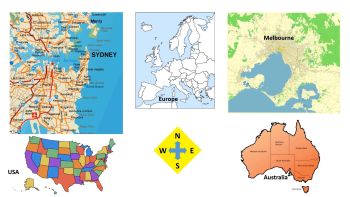
North is the direction towards the north pole of the Earth, and south is the direction towards the south pole of the Earth. East is to the right if you’re facing north, while west is to the left. If it helps, you can think of Western Australia being on the western side of Australia. Where else would it be? The equator runs along an east-west line. Half the Earth is north of the equator and we call it the northern hemisphere, and of course the other half is south of the equator and we call that region the southern hemisphere. I live in Melbourne, Australia, in the southern hemisphere.
Maps are nearly always drawn with north at the top of the page or screen.
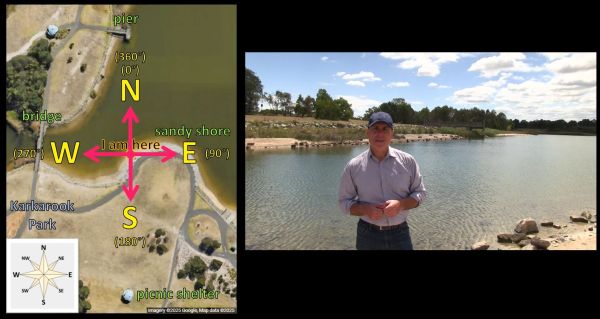 I’m standing here at Karkarook Park (in Melbourne’s south east suburbs), which you can also see as a map on google maps. The camera is facing north and you can see that pier over there. That pier is to the north of where I’m standing. If I move over to here, the camera turns 90 degrees and it’s now facing east and you can see some of the sandy shore of the lake and the rest of the lake in the distance. If I move over to here, the camera turns another 90 degrees and the camera is now facing south. It’s turned a total of 180 degrees. You can see that picnic shelter over there. That picnic shelter is to the south of where I’m standing. If I move around another 90 degrees, the camera has now turned 270 degrees all up and its now facing west and you can see that bridge over there, which is to the west of where I’m standing. If I move back to where I started, the camera has now turned a full 360 degrees, it’s facing north again, and you can see the pier again.
I’m standing here at Karkarook Park (in Melbourne’s south east suburbs), which you can also see as a map on google maps. The camera is facing north and you can see that pier over there. That pier is to the north of where I’m standing. If I move over to here, the camera turns 90 degrees and it’s now facing east and you can see some of the sandy shore of the lake and the rest of the lake in the distance. If I move over to here, the camera turns another 90 degrees and the camera is now facing south. It’s turned a total of 180 degrees. You can see that picnic shelter over there. That picnic shelter is to the south of where I’m standing. If I move around another 90 degrees, the camera has now turned 270 degrees all up and its now facing west and you can see that bridge over there, which is to the west of where I’m standing. If I move back to where I started, the camera has now turned a full 360 degrees, it’s facing north again, and you can see the pier again.
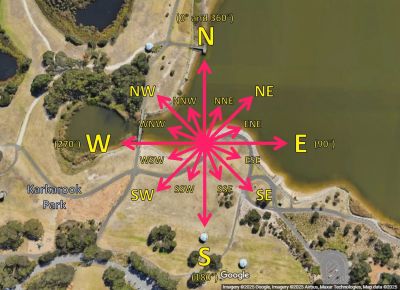 North, East, South, and West can be remembered with simple mnemonics like Never Eat Sea Weed. Between these directions you get North East, halfway between north and east, South East, South West, and North West. If you’re facing slightly more north than exactly north east, you can say north north east (NNE) but if you’re facing a little more towards the east than exactly north east, you’re facing east north east (ENE). The same applies to east south east, and so on all the way around.
North, East, South, and West can be remembered with simple mnemonics like Never Eat Sea Weed. Between these directions you get North East, halfway between north and east, South East, South West, and North West. If you’re facing slightly more north than exactly north east, you can say north north east (NNE) but if you’re facing a little more towards the east than exactly north east, you’re facing east north east (ENE). The same applies to east south east, and so on all the way around.
So, why does the Sun appear to rise in east?
The reason that the Sun seems to rise in the east is that the Earth is spinning from west to east, anticlockwise if you look at it from above the north pole.


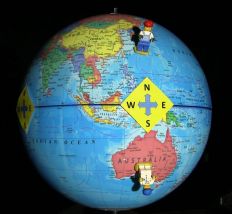

So, you have to face towards the east in the morning to see the Sun rising above the horizon, although not necessarily exactly east.
In the middle of the day, when the Sun is high overhead, you have look upwards of course to see the Sun.
If you’re in the southern hemisphere you have to face upwards and look towards the north to see the Sun and your shadow will be pointing towards the south, while if you’re in the northern hemisphere, you have to face upwards towards the south to see the Sun and your shadow will be pointing towards the north.
At the end of the day, when the Sun sets, regardless of which hemisphere you’re in, you have to face towards the west to see the setting Sun, although not necessarily exactly west.
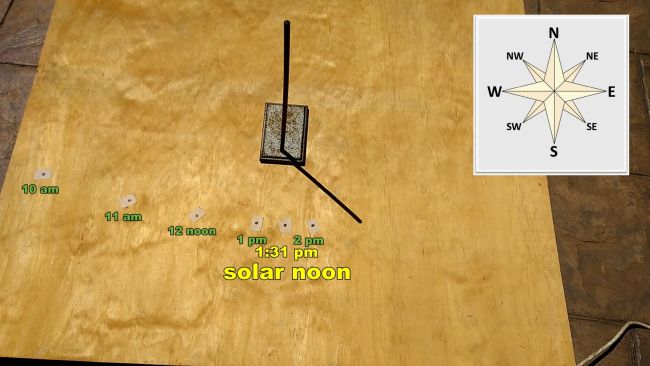 Now despite knowing that the Earth is spinning, it’s still perfectly acceptable to talk about the Sun’s apparent movement across the sky throughout the day.
Now despite knowing that the Earth is spinning, it’s still perfectly acceptable to talk about the Sun’s apparent movement across the sky throughout the day.
Here I set up a retort stand on a flat board. The time lapse shows the movement of the retort stand’s shadow throughout the day. I placed a piece of masking tape onto the board and made a mark on the tape so that we can see the progression of the shadow more easily. I could have just drawn directly onto the wood, but I was actually worried that I might bump the camera or the board and ruin the shot, in which case I could just remove the tape and try again on the next sunny day. As it turned out, the 9-hour shot worked out fine.
In the morning, the Sun was in the east and hadn’t risen very high, so the shadow was pointing westwards and was fairy long. As the Sun rose higher and higher in the sky, the shadow got shorter and shorter AND as the Sun moved towards the west, the shadow moved towards the east. When the Sun got to its highest point, let me freeze frame it, the shadow was at its shortest AND the Sun was directly north of the retort stand while the shadow pointed directly south. The top of the retort stand and the tip of the shadow were exactly in a north-south line. The time of the day that the Sun reaches its highest point is called solar noon which on this day was at 1:31 pm.
After solar noon, the Sun continued to move westwards, but it started getting lower and lower in the sky. As a result, the shadow got longer and longer and started to point more towards the east. In fact, quite obviously, the shadows of the trees that were over to the west of the setup (that is left of screen) also made an appearance!
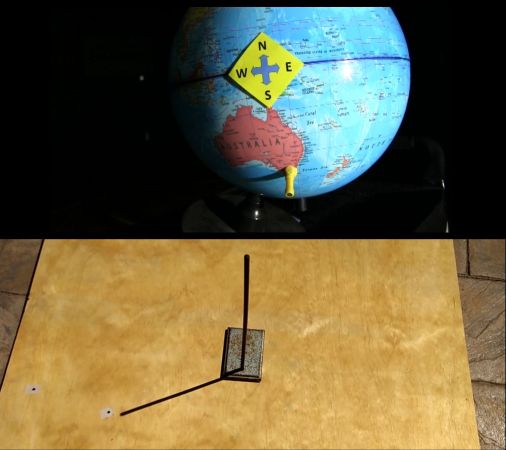
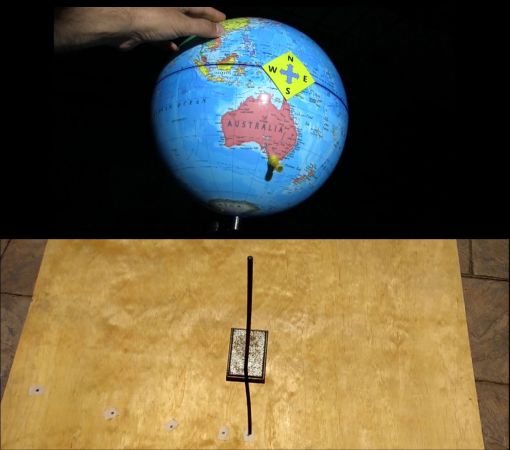 Now this time lapse is exactly the same as what you’re seeing now in the model. In both situations, there’s a really bright light shining onto the surface of a sphere, and an upright object in Melbourne, Australia (in the southern hemisphere) is casting a shadow.
Now this time lapse is exactly the same as what you’re seeing now in the model. In both situations, there’s a really bright light shining onto the surface of a sphere, and an upright object in Melbourne, Australia (in the southern hemisphere) is casting a shadow.
If I backtrack to the morning, the Sun is in the east and the long shadow points towards the west. As the Earth turns, the shadow gets shorter and shorter until solar noon when it’s at it shortest and it’s pointing south. Let me go to the other side. After that, the shadow gets longer and longer as the Sun goes down and ends up pointing towards the east since the Sun is in the western sky.
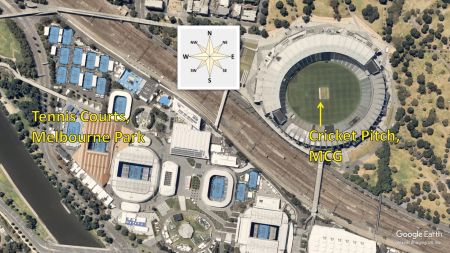 Because of the way that the Sun appears to move across the sky, tennis courts, like these ones here at Melbourne Park, and cricket pitches, like this one at the MCG, and most sporting grounds, are usually orientated to run north south or at least very close to north south. Why is that? Well, it helps to keep the Sun out of your eyes! If you’re playing tennis, for example, on a court that’s running north south, the ball generally goes either north or south.
Because of the way that the Sun appears to move across the sky, tennis courts, like these ones here at Melbourne Park, and cricket pitches, like this one at the MCG, and most sporting grounds, are usually orientated to run north south or at least very close to north south. Why is that? Well, it helps to keep the Sun out of your eyes! If you’re playing tennis, for example, on a court that’s running north south, the ball generally goes either north or south.
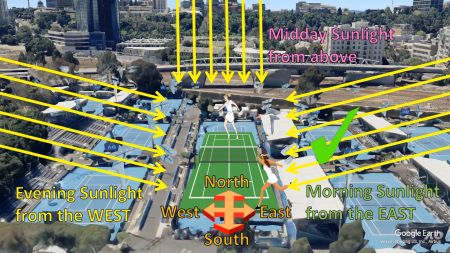 If you’re playing in the early morning, the Sun is low in the eastern sky, but it doesn’t usually shine directly into your eyes because you’re facing either north or south most of the time. Not having the Sun in your eyes obviously makes it easier. If you’re playing later in the day when the Sun is low in the western sky, again, it won’t shine directly into your eyes because, again, you’re facing either north or south most of the time.
If you’re playing in the early morning, the Sun is low in the eastern sky, but it doesn’t usually shine directly into your eyes because you’re facing either north or south most of the time. Not having the Sun in your eyes obviously makes it easier. If you’re playing later in the day when the Sun is low in the western sky, again, it won’t shine directly into your eyes because, again, you’re facing either north or south most of the time.
 If the tennis courts were aligned east west, players facing east in the morning or west in the afternoon would find it very difficult to play because the Sun would be shining directly into their eyes.
If the tennis courts were aligned east west, players facing east in the morning or west in the afternoon would find it very difficult to play because the Sun would be shining directly into their eyes.
North South alignment is just better. Of course, if you’re playing in the middle of the day, the Sun is higher in the sky so it doesn’t really shine directly into your eyes regardless of which way the court is aligned, but a north south orientation means that the court is useable all day, not just in the middle of the day.
Tennis players would find it very difficult to play tennis if they had to face into the setting Sun so the court is aligned to stop that from happening. A very basic knowledge of astronomy, star laws, even helps us orientate sporting fields.
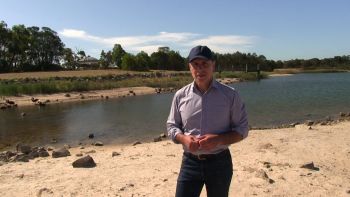 And so, that’s it. Day and night is caused by the spinning of the Earth every 24 hours. About half the time we’re on the side of the Earth facing the Sun and it’s daytime and about half the time we’re on the side of the Earth that’s facing away from the Sun and it’s nighttime. The Sun rises in the east, gets to its highest point in the sky at solar noon, and then sets in the west.
And so, that’s it. Day and night is caused by the spinning of the Earth every 24 hours. About half the time we’re on the side of the Earth facing the Sun and it’s daytime and about half the time we’re on the side of the Earth that’s facing away from the Sun and it’s nighttime. The Sun rises in the east, gets to its highest point in the sky at solar noon, and then sets in the west.
Thanks for watching, see you in the next episode!
CREDITS:
Some clipart was provided by Vecteezy: https://www.vecteezy.com/free-vector/tennis
Map of Globe by TUBS. Creative Commons License https://commons.wikimedia.org/wiki/File:Papua_New_Guinea_on_the_globe_(Southeast_Asia_centered).svg
Google Maps https://www.google.com/maps/
Star Wars Style March by Humanoide_Media
https://pixabay.com/music/main-title-star-wars-style-march-165111/
Invasion March – Star Wars Style Cinematic Music by Humanoide_Media
https://pixabay.com/music/main-title-invasion-march-star-wars-style-cinematic-music-219585/



